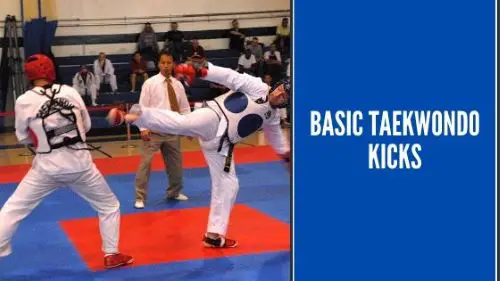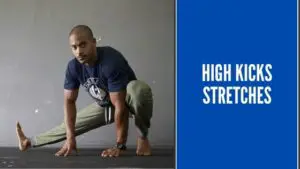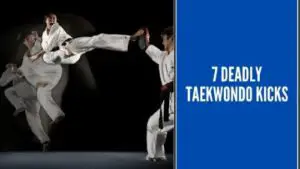Taekwondo is a very complete sport and includes many kicks techniques. The movements often require the simultaneous use of a series of different muscles. The trainee had to master each form with precision, speed, strength, and coordination.
Perfect execution is nothing more than a series of kinetic chain commands that stimulate multiple muscle groups at the same time.
First, training breeds a noticeable improvement in muscle elasticity and joint mobility increased cardio-respiratory efficiency and strengthening of the legs and trunk, necessary and useful factors to pull high kicks, reduce the risk of injuries and physical adaptation to Taekwondo. A lack of supervision causes neophytes to develop joint problems.
The basic taekwondo kicks include front kick, the circular forward kick also known as dollyo kick, sidekick.
Front kick – Apchagi
This is the first Taekwondo kick you learn, and it is divided into four basic actions. The front kick is used to hit the opponent in the face and can be used to reach the opponent in the abdomen to hit or push.
The movement must be mastered in its four phases before becoming fluid. The four parts are: Raise the knee, extend the leg, retract the leg keeping the knee raised, and return to the initial position.
It is taught to children, who take their first exam in a demonstration of mastery of this fundamental kick.
How to perform the Apchagi:
- Start in the front stance with feet slightly apart (the leg you will use to hit is the back leg)
- Move the center of gravity forward by squeezing the buttocks and slightly protruding the pelvis forward to position the weight on the front leg
- When you feel the back-foot rise and stay on the toes, bend the knee of the back leg forward
- Bring the knee of your back leg in front of you, ideally at chest height (you must keep your balance and maintain control)
- Stretch the leg along its entire length
- Stay focused on the sensations of your leg, and when you have reached the maximum extension, consciously retract it to the previous position
- Return the bent knee to its starting position by moving the weight slightly backward
- Rest your foot by landing in the central part of the sole.
The movement must be mastered in the four phases to improve limb control and elasticity. Fluidity is acquired with repetitions of the correct form. Common mistakes are to “forget” the leg after stretching it, causing excessive stress to the limb and joints.
When used to strike, the foot is used as the tip of a spear, and the toes are used to reach specific vulnerable points.
When you want to push the opponent, the movement can exploit the weight of the attacker who only has to move the center of gravity further forward (in this case the knee must be brought to the chest while the position of the attacker becomes slightly oblique to the ground).
Due to its simplicity of execution, this kick can be used by beginners, who must learn to improve their flexibility to master the correct shape.
This move is particularly appreciated in the film industry, as its direction and execution demonstrate a sense of strength and imposition on the opponent. Actors like Jason Statham make abundant use of it.
Roundhouse Kick – Dollyo chagi
Among the basic taekwondo kicks, this technique immediately reminds of Taekwondo to the general audience.
Circular or roundhouse kick techniques are applied in combat when the opponent adopts a lateral, sideways position, or keeps a very closed guard. The opponent who acts in this way wants to avoid any type of direct attack, and therefore his vital points can only be reached by indirect trajectory techniques.
The way to properly perform this kick is to twirl the hip and at the same time extend the leg to hit.
The body must lean forward significantly, while performing a half-turn in the opposite direction to that of the kick, to keep a good balance before correctly retract the striking foot.
How to perform the Dollyo Chagi:
- Start in the front stance
- Move the center of gravity forward and rotate the front foot 140-degree outwards, pivoting on the ball of the foot.
- Use the pelvis to rotate during the maneuver and allow the rear knee to bend while gaining height
- Bend the knee of the rear leg, bringing it in front to the height of the chest
- Extend your leg to hit the target obliquely (if you don’t use a target, stretch your leg carefully, without exceeding)
- Retract your leg to the bent knee position.
- Bring your leg back to the ground by rotating your pelvis.
The roundhouse kick is used to hit the opponent’s face, abdomen, and legs and is based on the correct control of our balance. Mastery of this move requires coordination and timing.
You can learn it after learning the front kick and if the practitioner lacks coordination, you can separate the rotation of the support foot. Perform the rotation after bringing the knee frontally to the chest, as in the front kick.
To hit, use the instep like most martial arts that share this technique do (karate, wushu, capoeira, etc.). Do not use toes to hit your target, as they may cause injury.
Related article: The Benefits of Taekwondo
Side kick – Yeop Chagi
This technique is a variation of the front kick and is taught to properly use the outside edge of the foot. During a fight, hitting with a sidekick proves to be a quick and almost stealthy move.
It is a very technical and very devastating kick: it targets the opponent’s centerline. This kick is learned by performing it in the neutral position with feet shoulder-width apart, and subsequently, the execution can be modified to use it in a front stance that amplifies its impact capacity.
How to perform the Yeop Chagi:
- Start in a Naranhi Seogi stance (feet shoulder-width apart)
- Shift your weight onto your right leg by tilting your torso to the right
- Raise your left knee to chest height
- Stretch the left leg (heel, buttocks, and shoulder must remain on the same imaginary line)
- Retract the leg
- Place your foot on the ground in the initial position
The support foot can rotate together with the hip by about 90 degrees to allow the blow to be more explosive. The height you can reach depends on the flexibility gained through training.
This specification only applies to high blows aimed at the face, when it is natural to experience the support foot lifting. Otherwise, the support foot should remain firmly planted on the ground to ensure greater force applied to the target.
If you found our Basic Taekwondo Kicks overview helpful then let us know by giving us a share. If you got any other mixed martial arts request or just more Muay Thai training guides, then send us a message.







